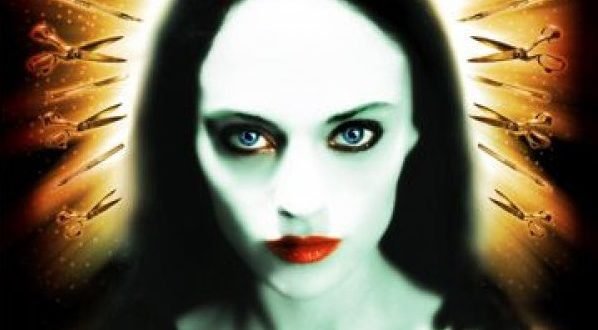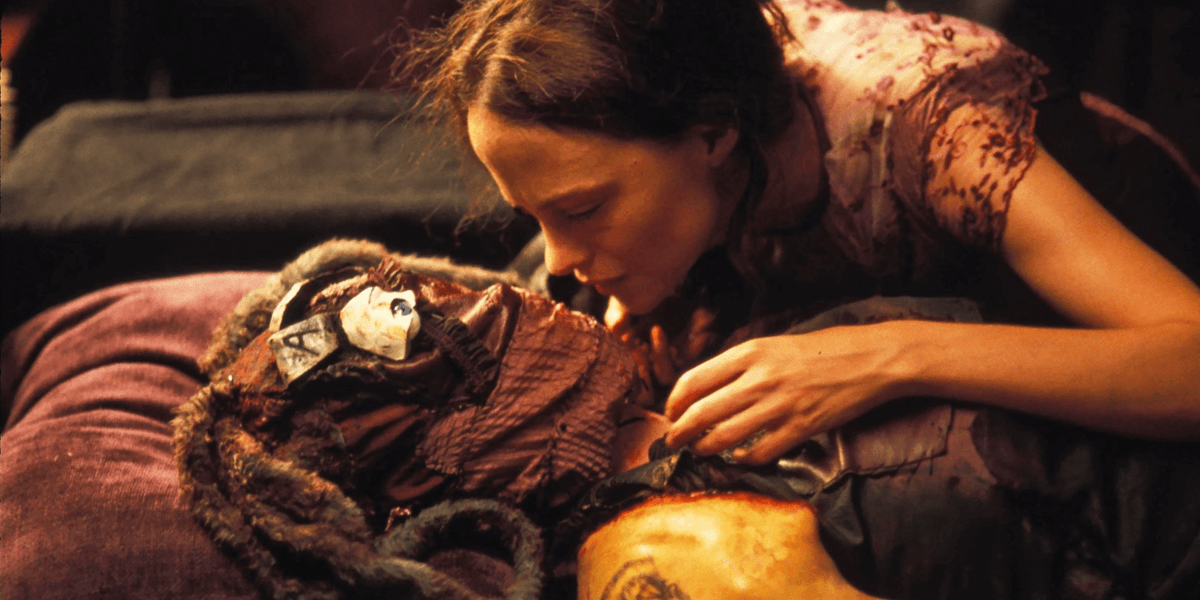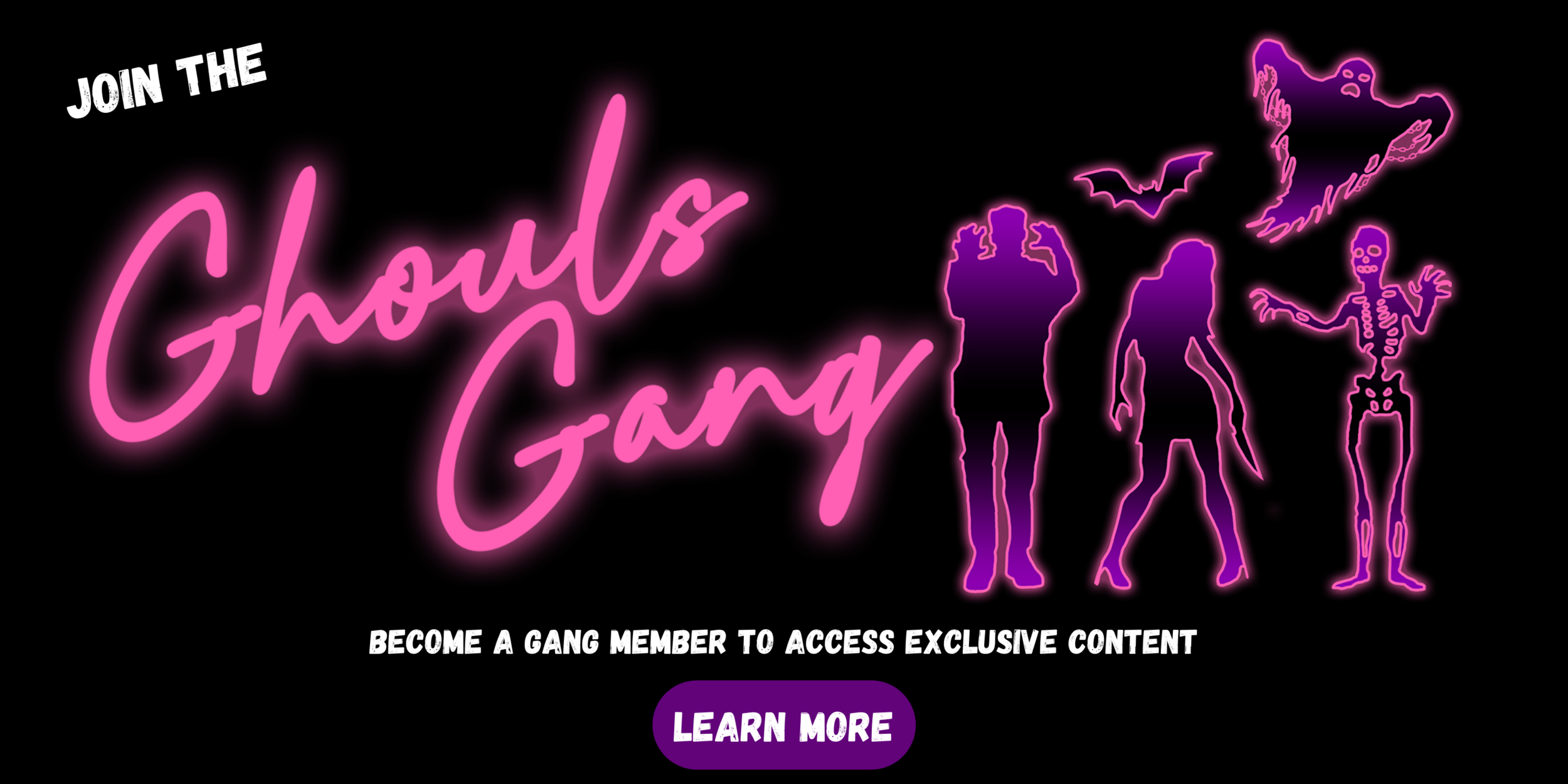[Editorial] The Low-Key Bisexuality of May (2002)

Lucky McKee's cult classic May (2002) introduces viewers to a lonely young woman (Angela Bettis) who longs for connection and understanding. The titular May had a lazy eye as a child, and her mother was hyper focused on her child's "abnormal" appearance. May had the misfortune of being raised by an emotionally abusive parent, who kept her isolated and contributed to her inability to socialize.
May's only childhood friend was a doll (whom her mother insisted couldn't be removed from her glass case) named Suzie. While Suzie proves to be a good confidante and source of comfort, May grows up and knows that she needs something more. As she starts to experience a sexual awakening, she tells Suzie, "I need a real friend— someone I can hold."
Despite May's social awkwardness, she is charmingly quirky, winning over both men and women during the film, and although she doesn't explicitly identify as bisexual, she is drawn toward people regardless of their gender or sexual identity. Her oft-quoted line "So many pretty parts, and no pretty wholes" can be read differently through a queer lens. She is able to see desirable parts in everyone she meets. Unfortunately, the fact that most people she meets are missing desirable personalities leads to her sad conclusion: there are no pretty wholes.
May meets mechanic-slash-filmmaker Adam (Jeremy Sisto) at the beginning of the film, and she's immediately smitten with him and his beautiful hands. While daydreaming about getting closer to Adam, she also begins a flirtation with her queer colleague Polly (Anna Faris). May compliments Polly, telling her, "You have a beautiful neck," and Polly excitedly reciprocates, telling May to come to her place to hang out and "eat some melons."

Adam is characterized as hypermasculine. He works with cars and shows up at the local café in his coveralls and five o'clock shadow. He's an extreme contrast with Polly, who dresses very feminine in halter tops and dresses, and bats her eyelashes at May. The casting of Sisto and Faris works perfectly to show the wide variety of people to whom May is attracted.
However, they both have something in common: they're open to the dark side. Adam makes movies about cannibals who ravenously feast on one another; Polly is shocked when May pricks her with a scalpel at work, but then tells her, "I kinda liked it… do me again." May feels that she can be her real self around Adam and Polly. She lets down her guard and assumes they're just as off-kilter as she is.
Adam and May begin a short-lived relationship, which sours when she emulates his gruesome zombie movie by biting his lip and drawing blood during a make-out session. May reminds him that he told her she likes weird stuff, and he replies, "Not that weird."
HAVE YOU LISTENED TO OUR PODCAST YET?
![[Ghouls Podcast] Maniac (2012) with Zoë Rose Smith and Iona Smith](https://images.squarespace-cdn.com/content/v1/5fe76a518d20536a3fbd7246/1696356006789-NYTG9N3IXCW9ZTIJPLX2/maniac.jpg)
A heartbroken May is still being pursued by Polly, possibly the least subtle character in all of film history:
Polly: Do you like pussy?
May: What?
Polly: Cats? Do you like pussycats? Jeez, you're a nasty little thing, aren't you?
While May is surprised by Polly's advances, she's also attracted to her, and the two share a night together, which is marred only by May noticing a mole on Polly's hand, which marks her as another imperfect whole. Like her relationship with Adam, May's relationship with Polly doesn't last long. When she realizes that the aptly named Polly is polyamorous, she becomes frustrated and breaks things off with her.

While it's true that May does not handle these breakups well— she begins collecting all the prettiest body parts from the people she knows to create one pretty whole— she also doesn't fall into the evil bisexual stereotype that is ever present in television and film. Sadly, based on real-life negative stereotypes, bisexuals in pop culture are often portrayed as duplicitous, ruthless and greedy. May manages to sidestep these stereotypes. While her romantic partners may have possessed these qualities (both Adam and Polly misled her and treated her carelessly), May herself did not. She remains sympathetic because she's still a lonely woman searching for a true connection.
The refreshing thing about May is that her sexuality— through a huge part of the plot as she comes into her own and begins dating— is not part of the problem or an issue she struggles with. Her relationships with both Adam and Polly (while awkward) aren't fraught with any kind of inner turmoil about her sexual orientation. Unlike many other films featuring LGBTQ+ folks, May doesn't portray the fact that May is queer as something that gets in her way or causes conflicts. Her sexuality is a normal part of her experience.
Even the "friend" she puts together from other people's body parts at the conclusion of the film can be read as an expression of her sexuality: she uses both male and female parts to put together the ideal whole person. While her search for romantic love was ultimately unsuccessful, her attraction to the beauty that exists in different genders makes May a bisexual horror icon.
RELATED ARTICLES
Films that blend horror with romance always fascinate me; add a niche contemporary setting that I’ve never heard of before and I’m hooked. Cannibal Mukbang was made by Aimee Kuge, a young woman from New York, and I was privileged to spend a little time talking with her over Zoom…
Now it’s time for Soho’s main 2023 event, which is presented over two weekends: a live film festival at the Whirled Cinema in Brixton, London, and an online festival a week later. Both have very rich and varied programmes (with no overlap this year), with something for every horror fan.
In the six years since its release the Nintendo Switch has amassed an extensive catalogue of games, with everything from puzzle platformer games to cute farming sims to, uh, whatever Waifu Uncovered is.
A Quiet Place (2018) opens 89 days after a race of extremely sound-sensitive creatures show up on Earth, perhaps from an exterritorial source. If you make any noise, even the slightest sound, you’re likely to be pounced upon by these extremely strong and staggeringly fast creatures and suffer a brutal death.
Have I told you about Mayhem Film Festival before? It’s a favourite event of mine, so I’ve blurted about it in anticipation to many people I know. The event has just passed, so now is the time to gush its praises to those I don’t know.
Loop Track, Thomas Sainsbury’s directorial debut, has such a sparse description that it’s really difficult to know what you’re stepping into when it starts. It’s about Ian (played by the director), who is taking a trek through the New Zealand bush….
For a movie that doesn’t even mention the word “vampire” once throughout the length of the film, Near Dark (1987) is a unique entry in the vampire film genre.
If you like cults, sacrificial parties, and lesbian undertones then Mona Awad’s Bunny is the book for you. Samantha, a student at a prestigious art university, feels isolated from her cliquey classmates, ‘the bunnies’.
Kicking off on Tuesday 17th October, the 2023 edition considers the cinematic, social and cultural significance of the possessed, supernatural and unclean body onscreen.
I was aware of the COVID-19 pandemic before I knew that’s what it would be called, and before it ever affected me personally. My husband is always on top of world events, and in late 2019, he explained what was happening around the globe.

EXPLORE
Now it’s time for Soho’s main 2023 event, which is presented over two weekends: a live film festival at the Whirled Cinema in Brixton, London, and an online festival a week later. Both have very rich and varied programmes (with no overlap this year), with something for every horror fan.
In the six years since its release the Nintendo Switch has amassed an extensive catalogue of games, with everything from puzzle platformer games to cute farming sims to, uh, whatever Waifu Uncovered is.
A Quiet Place (2018) opens 89 days after a race of extremely sound-sensitive creatures show up on Earth, perhaps from an exterritorial source. If you make any noise, even the slightest sound, you’re likely to be pounced upon by these extremely strong and staggeringly fast creatures and suffer a brutal death.
If you like cults, sacrificial parties, and lesbian undertones then Mona Awad’s Bunny is the book for you. Samantha, a student at a prestigious art university, feels isolated from her cliquey classmates, ‘the bunnies’.
The slasher sub genre has always been huge in the world of horror, but after the ‘70s and ‘80s introduced classic characters like Freddy Krueger, Michael Myers, Leatherface, and Jason, it’s not harsh to say that the ‘90s was slightly lacking in the icon department.
Mother is God in the eyes of a child, and it seems God has abandoned the town of Silent Hill. Silent Hill is not a place you want to visit.
Being able to see into the future or back into the past is a superpower that a lot of us would like to have. And while it may seem cool, in horror movies it usually involves characters being sucked into terrifying situations as they try to save themselves or other people with the information they’ve gleaned in their visions.
Both the original Pet Sematary (1989) and its 2019 remake are stories about the way death and grief can affect people in different ways. And while the films centre on Louis Creed and his increasingly terrible decision-making process, there’s no doubt that the story wouldn’t pack the same punch or make the same sense without his wife, Rachel.
The story focuses on a group of survivors after most of the world’s population is wiped out by Captain Trips, a lethal super-flu. And while there are enough horrors to go around in a story like this, the real focus of King’s book is how those who survive react to the changing world around them.
While some films successfully opt to leave the transformation scene out completely, like the wonderful Dog Soldiers (2002), those who decide to include it need to make sure they get it right, or it can kill the whole vibe of the film. So load up on silver bullets, mark your calendar for the next full moon, and check out 11 of the best werewolf transformations!


![[Ghouls Podcast] The Last House on the Left (2009) with Zoë Rose Smith and Jerry Sampson](https://images.squarespace-cdn.com/content/v1/5fe76a518d20536a3fbd7246/1687863043713-54DU6B9RC44T2JTAHCBZ/last+house+on+the+left.jpg)
![[Ghouls Podcast] The Bay (2012) with Ariel Powers-Schaub & Amber T](https://images.squarespace-cdn.com/content/v1/5fe76a518d20536a3fbd7246/1684751617262-6K18IE7AO805SFPV0MFZ/The+Bay+website+image.jpg)
![[Ghouls Podcast] Picnic at Hanging Rock (1975) with Zoë Rose Smith & Rebecca McCallum](https://images.squarespace-cdn.com/content/v1/5fe76a518d20536a3fbd7246/1682536446302-I2Y5IP19GUBXGWY0T85V/picnic+at+hanging+rock.jpg)
![[Ghouls Podcast] Psychotic Women in Horror with Zoë Rose Smith & Mary Wild](https://images.squarespace-cdn.com/content/v1/5fe76a518d20536a3fbd7246/1678635495097-X9TXM86VQDWCQXCP9E2L/Copy+of+Copy+of+Copy+of+GHOULS+PODCAST+THE+LOVED+ONES.jpg)
![[Ghouls Podcast] Nekromantik with Zoë Rose Smith & Rebecca McCallum](https://images.squarespace-cdn.com/content/v1/5fe76a518d20536a3fbd7246/1677422649033-Z4HHPKPLUPIDO38MQELK/feb+member+podcast.jpg)
![[Ghouls Podcast] Final Destination 5 & Wrap-up with Ariel Powers-Schaub & Iona Smith](https://images.squarespace-cdn.com/content/v1/5fe76a518d20536a3fbd7246/1672841326335-WER2JXX7WP6PO8JM9WB2/PODCAST+BONUS+2023+%284%29.jpg)
![[Ghouls Podcast] Final Destination 3 & 4 with Ariel Powers-Schaub & Iona Smith](https://images.squarespace-cdn.com/content/v1/5fe76a518d20536a3fbd7246/1672841151148-U152EBCTCOP4MP9VNE70/PODCAST+BONUS+2023+%283%29.jpg)
![[Ghouls Podcast] Final Destination 1 & 2 with Ariel Powers-Schaub & Iona Smith](https://images.squarespace-cdn.com/content/v1/5fe76a518d20536a3fbd7246/1672841181605-5JOOW88EDHGQUXSRHVEF/PODCAST+BONUS+2023+%282%29.jpg)
![[Ghouls Podcast] Henry: Portrait of a Serial Killer (1986)](https://images.squarespace-cdn.com/content/v1/5fe76a518d20536a3fbd7246/1672841247731-65K0JKNC45PJE9VZH5SB/PODCAST+BONUS+2023+%281%29.jpg)
![[Ghouls Podcast] A Serbian Film with Rebecca and Zoë](https://images.squarespace-cdn.com/content/v1/5fe76a518d20536a3fbd7246/1672841382382-RY0U5K7XD4SQSTXL2D14/PODCAST+BONUS+2023.jpg)
![[Editorial] Soho Horror Film Festival: Interview with Aimee Kuge on Cannibal Mukbang](https://images.squarespace-cdn.com/content/v1/5fe76a518d20536a3fbd7246/1701808004722-9M8SZ2UXY52QBQBR4NTI/img20230818_15150780.JPG)
![[Editorial] 10 Films & Events to Catch at Soho Horror Film Fest 2023](https://images.squarespace-cdn.com/content/v1/5fe76a518d20536a3fbd7246/1700819417135-299R7L4P0B676AD3RO1X/Screenshot+2023-11-24+at+09.41.52.png)
![[Editorial] 9 Horror Nintendo Switch Games To Play](https://images.squarespace-cdn.com/content/v1/5fe76a518d20536a3fbd7246/1697214470057-3XZXX8N4LYIMDFWS6Z3P/Screenshot+2023-10-13+at+17.20.13.png)
![[Mother of Fears] Mothering in Silence in A Quiet Place (2018)](https://images.squarespace-cdn.com/content/v1/5fe76a518d20536a3fbd7246/1696445921315-HZJ2DZYQIH6VVWXBO2YL/Screenshot+2023-10-04+at+19.52.29.png)
![[Event Review] Highlights from Mayhem Film Festival 2023](https://images.squarespace-cdn.com/content/v1/5fe76a518d20536a3fbd7246/1697624582491-MPT2VB9RRGU6OG7L6UKL/Mayhem+2023.jpg)
![[Editorial] Mayhem Festival: Interview with Thomas Sainsbury on Loop Track (2023)](https://images.squarespace-cdn.com/content/v1/5fe76a518d20536a3fbd7246/1697186472899-WC4RR0TW7L7LMFEBGPA2/Tom+Sainsbury.jpg)
![[Editorial] Keeping Odd Hours: A Retrospective on Near Dark (1987)](https://images.squarespace-cdn.com/content/v1/5fe76a518d20536a3fbd7246/1696445070868-HU9YIL3QPBCL1GW47R3Z/Screenshot+2023-10-04+at+19.36.53.png)
![[Editorial] 5 Female Focused Horror Book Recommendations](https://images.squarespace-cdn.com/content/v1/5fe76a518d20536a3fbd7246/1696441981361-52EQCTJ7AT2QF1927GM7/919xtm6d3fL._AC_UF894%2C1000_QL80_.jpg)
![[Editorial] What to Watch at This Year's Cine-Excess International Film Festival 2023](https://images.squarespace-cdn.com/content/v1/5fe76a518d20536a3fbd7246/1697213510960-REV43FEOZITBD2W8ZPEE/Screenshot+2023-10-13+at+17.01.15.png)
![[Editorial] Cherish Your Life: Comfort in the SAW Franchise Throughout and Beyond the COVID-19 Pandemic](https://images.squarespace-cdn.com/content/v1/5fe76a518d20536a3fbd7246/1695487675334-MYPCPYYZQZDCT548N8DI/Sc6XRxgSqnMEq54CwqjBD5.jpg)






















![[Editorial] 9 Best Slashers Released Within 10 Years of Scream (1996)](https://images.squarespace-cdn.com/content/v1/5fe76a518d20536a3fbd7246/1695478839037-LOFHGVM3H6BMSZW7G83M/Screenshot+2023-09-23+at+15.15.11.png)
![[Mother of Fears] Mother Vs. Monster in Silent Hill (2006)](https://images.squarespace-cdn.com/content/v1/5fe76a518d20536a3fbd7246/1695485781119-H6GNP0G3J2TLPAOIABV7/Screenshot+2023-09-23+at+17.11.56.png)
![[Editorial] 9 Terrifying Cerebral Visions in Horror Movies](https://images.squarespace-cdn.com/content/v1/5fe76a518d20536a3fbd7246/1693509801235-X23OL50T1DVGECH0ZJK2/MV5BMjQ0MTg2MjQ4MV5BMl5BanBnXkFtZTgwMTU3NDgxMTI%40._V1_.jpg)
![[Mother of Fears] I Don’t Wanna Be Buried in a Pet Sematary (1989) and (2019)](https://images.squarespace-cdn.com/content/v1/5fe76a518d20536a3fbd7246/1691328766069-QFNAVJOMFZVZ5CLU1RWM/Screenshot+2023-08-06+at+14.23.13.png)
![[Mother of Fears] How I Love to Love Nadine in The Stand (2020)](https://images.squarespace-cdn.com/content/v1/5fe76a518d20536a3fbd7246/1690213172707-TKM9MZXK02EVCIX30M1V/Screenshot+2023-07-24+at+16.29.11.png)
![[Editorial] 11 Best Werewolf Transformations in Horror Films](https://images.squarespace-cdn.com/content/v1/5fe76a518d20536a3fbd7246/1689240234098-HUPQC6L57AAHFJNT8FTE/Screenshot+2023-07-13+at+10.09.13.png)
